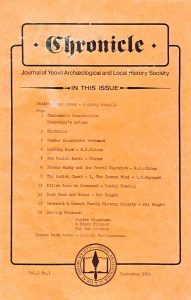1978-Sep-pg8-9_Thomas Hardy and the Yeovil District
This article came from the Chronicle published September 1978. Pages 8-9
THOMAS HARDY
& THE YEOVIL DISTRICT
Author: N.J.Atkins
The advent of the 1978 Hardy Festival in Dorchester to mark the 50th year since Thomas Hardy’s death brings to mind the fact that he and his first wife Emma Lavinia lived in rooms at No.7 Peter Street, Yeovil, in 1876, albeit for only a matter of about two months, before moving to Riverside Villa in Sturminster Newton, there to spend the happiest two years of their 36 years of marriage.
He had considered taking No.158 Hendford Hill but decided that a return to his native county of Dorset made a greater appeal, so, on a visit to Bristol to purchase E100 of furniture to furnish a home of their own, this ended the first two years of marriage in furnished rooms.
While in Yeovil he indulged in a favourite pastime of walking and in May 1876 he recorded in his diary – ‘In an orchard at Closworth, Cowslips under trees, a light proceeds from them, as from Chinese lanterns or glow worms’. Also ‘that in a village near Yeovil about 100 years ago, there lived a dumb woman, well known to my informant’s motheic, One day the woman suddenly spoke and said:
‘A cold winter, a forward Spring
A bloody Summer, a dead King.’
She then dropped dead. The French Revolution followed immediately after.
A true Hardy reminiscence!
Following a visit by car to Ilminster in 1926 and a return via Ham Hill, Thomas Hardy and his second wife Florence Emily stopped for tea at Maynards Cafe in The Borough, Yeovil, where a trio of musicians were playing. He had a great love of music and listened to their playing with great pleasure, expressing his delight at their performance. This little episode is mentioned in ‘The Life’ which, with the exception of the last few chapters, was written from notes and consultations between Mrs Hardy and her famous husband in the later years of his life, but published in two volumes in 1928 and 1930 by Messrs Macmillans as the work of his widow.
His short sojourn in Yeovil (which he called Ivel or Ivell) enabled him to use certain buildings in the town and district when writing short stories. Thus, in ‘For Conscience’ Sake’ (Life’s Little Ironies) he quotes the Rev. Percival Cope, curate of St Johns Church, Ivell, as living in St Peters Street, Ivell – the scene of his own one-time dwelling. Also in ‘A Tragedy of Two Ambitions’, he mentions that Joshua and Cornelius Halborough met their father at the Castle Inn, Iveil, The old Castle Inn in Yeovil was demolished during the last 50 years, the same fate overtaking the George Inn and most old or historic buildings in the town.
In his short story ‘Master John Horseleigh, Knight’ (A Changed Man) he sets the scene at Clyfton Horseleigh (Clifton Maubank) near Yeovil Junction, a house which he no doubt passed during one of his walks. Various characters are mentioned in his stories and poems as having passed through Ivell, but do not appear to have dallied there on their journeys. In his poems the town is mentioned in ‘The Homecoming’ (Time’s Laughingstocks), ‘The Pat of Butter’ (Human Shows), and in that spooky poem called ‘Vagg Hollow’ (Late Lyrics & Earlier) describing the experiences of a waggon-boy in the hollow near Half-way House, where ‘things” have been seen even in modern times!
In Hardy’s favourite poem ‘A Trampwoman’s Tragedy’ Ivelchester Jail and the River Yeo are featured. Probably the most interesting poem of local connection is ‘The Sea Fight’ (Human Shows & Far Fantasies) written in 1916 during the First World War and dedicated – In Memoriam Captain Prowse, 31 May 1916, in which Thomas Hardy describes him as – ‘Then while on earth we knew him/ as our fellow / as our fellow denizen’ – Captain Cecil Irby Prowse commanded HMS Queen Mary at the Battle of Jutland which was sunk by the German High Seas Fleet with the loss of 57 officers and 1209 men.
The Prowse family lived in the Yeovil area and in the north aisle of St John’s Church is a large stained glass window dedicated to the heroes of that family which includes Charles Bertie Prowse, DSO, and his brother Cecil Irby Prowse, Captain RN, who perished when the Battle Cruiser sank, He was 49 years of age. The sister of these two brothers was Mrs Henri G.B.Cowley, wife of the Vicar of Stinsford (Dorset), the church where Hardy was christened and in which churchyard his heart is buried. He knew the Vicar and his wife very well and also members of the family. I owe these poetic details to Professor J.D.Bailey’s excellent book ‘The Poetry of Thomas Hardy, a Handbook and Commentary’ (The University of North Carolina Press) which students of Hardy’s poetry would be well advised to study,
Hardy’s life-long interest in archaeology had always been keen, especially if connected with the Dorchester area, and only two months prior to his death, on 11 January 1928, he made a special, journey to nearby Fordington, to inspect a Roman tessellated pavement just uncovered. As he stepped out of the trench, this shy and reserved little man spoke to an attractive young lady standing by, saying ‘saying the vermiculate, of the tesserae then walking away, leaving her totally confounded, as she told me afterwards. Unfortunately he suffered a slight chill during that cold November day which eventually led to his last illness.
I am sure that the present, world-wide admiration of his works would have greatly surprised and gratified him, although he maintained that he would be remembered for his poetry which he thought more of than of his novels, and which is even more increasingly read and admired.
